As an Amazon Associate I earn from qualifying purchases.
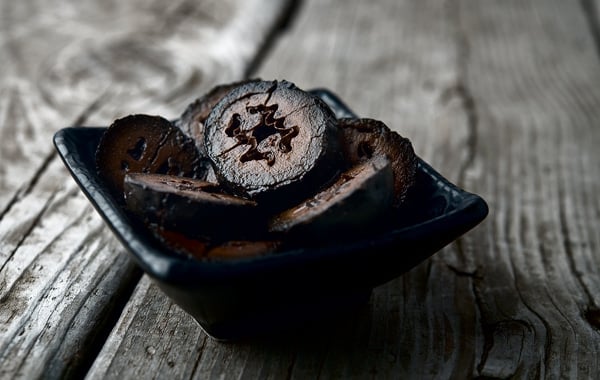
There may be a few foods that are more English than pickled walnuts, but with the possible exception of fish and chips, I can’t think of one. Chances are, however, you’ve never heard of them. I hadn’t, until several years ago when I ordered the meat-and-cheese plate at a local Irish place called deVere’s.
On this place was a black disk. I asked the waitress what on earth it was, and she smiled; she’d had this question before: “It’s a pickled walnut. It’s good with the cheddar.”
I followed her advice and stabbed the disk with my fork, adding a bit of cheddar cheese and a bit of cold roast beef to round things out. Wow. It was a bit like eating solid steak sauce, with a little floral aroma and a zephyr of bitterness that just barely let you notice it.
I ate another disk all by itself: Fairly soft, puckery and strangely floral. And yes, there was definitely a Worcestershire-Heinz 57-A1-thing going on here. How had I never had these before?
Turns out that very, very few people outside of Britain eat them. This should change, which is why I am presenting you with this recipe. And the reason I am posting this now is because you need to get out and get your walnuts now. That’s right, you need green, unripe walnuts to make pickles. And yes, you use the whole thing, hull and all.
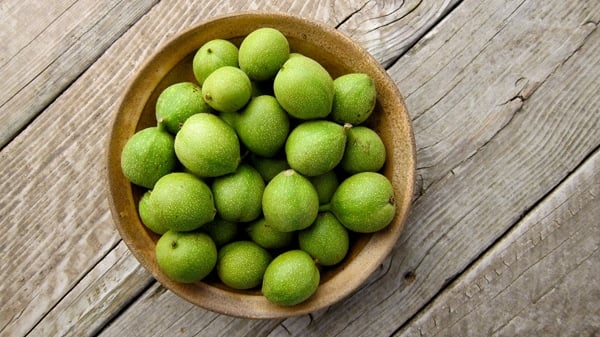
I got mine a few weeks ago, after an unsuccessful fishing trip with my friend Joe. We were in the Delta and as we were driving out, I noticed a NorCal black walnut (Juglans hindsii) absolutely laden down with nuts. “Pull over!” Joe, used to this by now, did. I gathered about 150 nuts in less than 15 minutes. It was a bonanza.
I knew I was in business right when I got to the tree, but just to be sure I pulled out my pocketknife and sliced an unripe nut in half. You need to do this, either with a knife or a stout needle or a long nail, because you have to catch the unripe walnuts before the shell forms. Once that shell forms inside the walnut’s hull, you’re too late; the traditional harvest date in England is late June.
The process for pickled walnuts is not hard at all, but it takes more than a week. You need to brine the green walnuts for a good long time before they will be ready to pickle properly. The brine time helps with preservation and removes some of the bitterness in the unripe walnuts. Once brine pickled, they are pretty durable.
Do you need to sun-blacken the walnuts? No, but doing so gives you a nice, uniform look to them. Otherwise they will be olive green in some places, blotchy black in others.
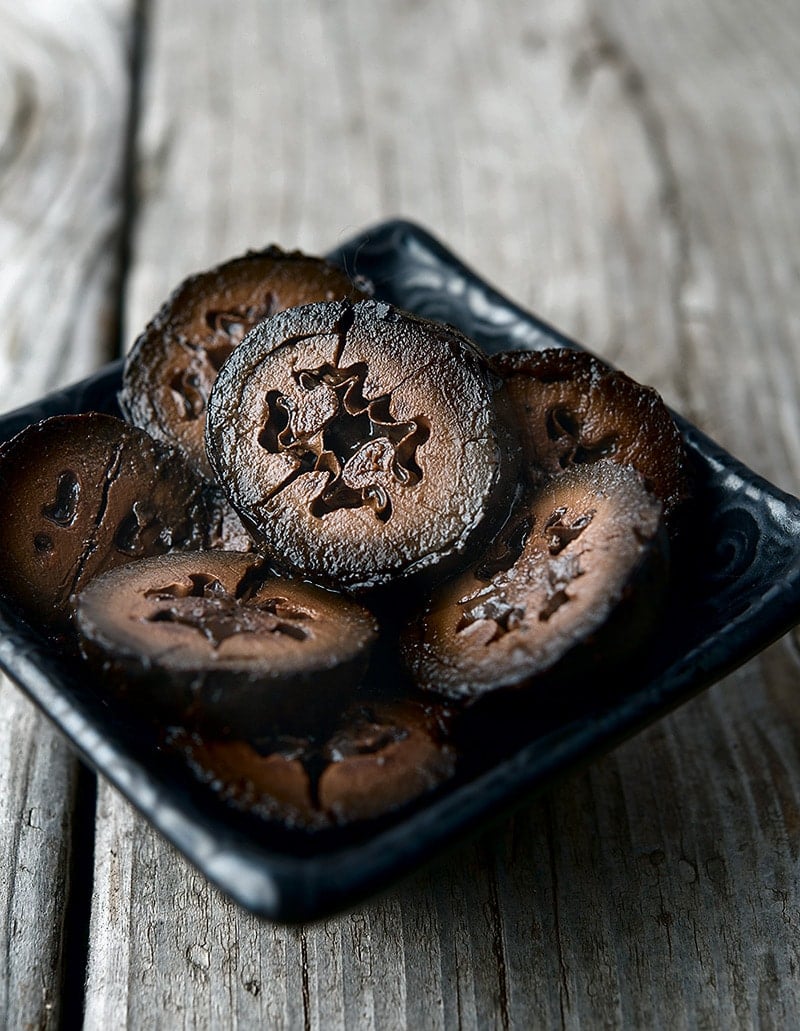
Once you have your pickled walnuts, what do you do with them? Look to the English. Traditionally they are part of a ploughman’s lunch, with other pickles, cheese and cold meats. But I see them a lot tossed into beef or lamb stews (pot pies and pasties, too!) in wintertime, and in summertime I’ve seen them served in cool salads alongside tomatoes, and accompanying shellfish such as scallops or shrimp.
Pickled Walnuts
Ingredients
- About 50 to 60 green, unripe walnuts
- 1/2 cup kosher salt
- 1/2 gallon water
- 2 quarts cider or malt vinegar
- 1 tablespoon cracked black pepper
- 1 tablespoon cracked allspice berries
- 1 ounce ginger, about 1 1/2-inch pieces, smashed
- 1 cup brown sugar
Instructions
- Dissolve the salt in the water to make a brine. Put on some rubber gloves if you have them, because walnut juice will stain your hands for weeks -- and it won't come off. Trust me on this one. Properly gloved, stab each walnut with a fork in several places; this helps the brine penetrate. Submerge the walnuts in the brine and let them ferment for 8 days at room temperature.
- Remove the walnuts and put them on a baking sheet and leave them outside in the sun for a day, until they turn uniformly black. You can do this step without gloves if you want.
- Pack the walnuts into quart jars. Bring the remaining ingredients to a boil and pour over the walnuts. Leave very little headspace in the jars. Seal and keep in a cool place, either the fridge or a basement -- you just want them to rest below 70°F -- for at least a month before you eat them. Kept this way they will last a year.
Notes
Nutrition
Nutrition information is automatically calculated, so should only be used as an approximation.
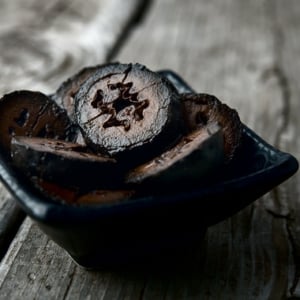
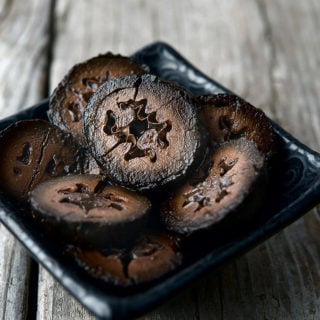
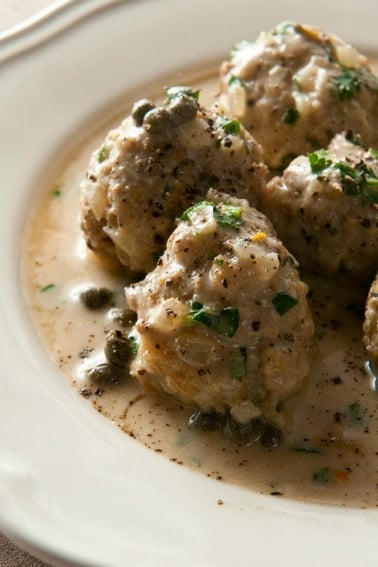
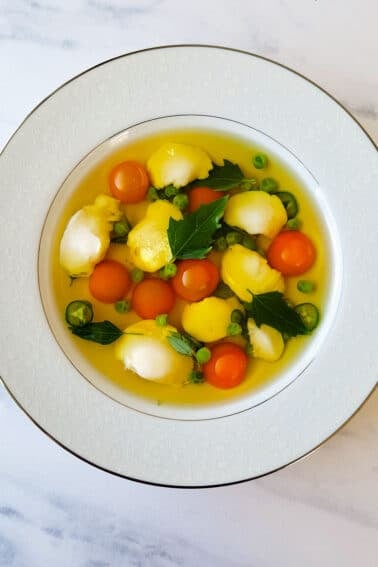
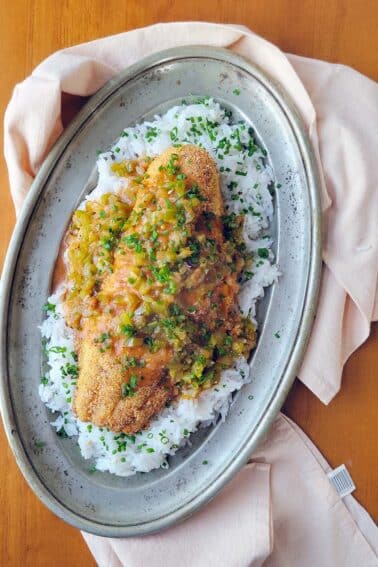
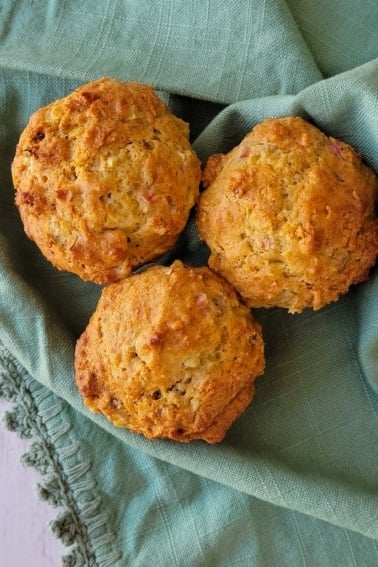
Hello, and thank you for this recipe. I have brined, blackened in the sun, and now wondering when you say seal the jars, do you mean just put a clean canning lid on them? Or do you mean to water bath process them to seal?
Catherine: I just put a clean lid on. They should be fine without processing, if you keep them cool, as in under 75 degrees.
Pick your walnuts by Midsummer Day to ensure the shells haven’t begun to form within. Also, you can re-use at least half of the pickling liquor for next year’s pickling. The remaining liquor could be used as a condiment, as an alternative to vinegar. Finally, your pickled walnuts will keep for months (at least) if they are kept cool – ideally in a fridge.
Hi Hank,
i hope you’re very well.
My name is Andrzej and I’m about to pickle some walnuts but the recipe left me unsure in 1 point.
I mean, after that 8 days of fermentation and taking all the walnuts out to the sun…do you drain the water with salt to the sink, or,you use it further by adding all the other ingredients and then boil them all together to follow the recipe?
BEST WISHES and thanks for sharing this recipe with us ?
Drain. You replace the brine with the vinegar.
This is a similar method as to how you make “icicle pickles’, with a short ferment and then a vinegar based pickle, although they use much more sugar.
Pickled walnuts keep much longer than a year. Vinegar can disolve the tops though.
I soaked the walnuts for 8 days and small spots of mold developed on the surface of the water. I drained and rinsed the walnuts and left them to dry. there isn’t any mold on the walnuts. Can I still use them?
Berenice: I would still use them, yes.
Just put down five jars!
Couldn’t find ginger
Hope it’s still ok!
HI HANK
I have just pickled my first batch of walnuts last week. My friend has a property in the Adelaide Hills called Walnuts
I was so fortunate to be able to gather 2 buckets of walnuts before they ripened. I am looking forward to trying them in a months time, my question is 30 days long enough?
liz
Shoot too late for me to make these in E. Tx but come next year I am going to do this. Right now they are all over the ground and are like being at a shooting range when we mow over them. I rake up piles of them.
They are so hard to crack, they usually are food for squirrels. We have several black walnut trees. Yep next year the squirrels are going to have to make do with acorns
Too bad I didn’t see this earlier in the spring. I could have tried another native walnut recipe.We have had a bumper crop of black walnuts here in eastern Ontario this year. I made another batch of nocino – the Italian green walnut liqueur as last year’s received positive reviews even from my born and raised in Napoli brother-in-law. I have found, depending on the weather, harvesting is best accokmplished around the 1st week of July when the nuts are a little smaller than ping pong balls.
I also tried the German rabbit stew. Delicious! Would definitely make again.
I’m following your recipe over in England Hank and my walnuts are going blacker by the day as they dry after brining. I’ve looked through some of the comments and noticed that you told someone that the recipe makes 3-4 pint jars. However the recipe says you need 2 quarts of vinegar that seems far to much or have I misunderstood something?
Some of the walnuts have small black spots and I’m not sure if the black goes inside the walnut. Does it work if I use half walnuts?
Jane: I’ve never tried that.
Can you use black walnuts for this recipe?
Kathi: Yes, if you get them early enough.
In my neighborhood the walnuts are still in their fuzzy, sticky, almond-sized phase, with just pith for a shell. Are they likely to be at a good state for pickling in a couple of weeks, or do the shells develop and harden that quickly?
Jo: If you can slice one in half easily with a paring knife, they’re good.
Dear Hank,
first thanks for you site which has inspired me over the years.
I have a green walnut question.
This is the first recipe I have seen that does not tell me to peel the walnuts.
Do you think that I could ALSO get away with not peeling them for a sweet preparation like glyko karydaki if I give them a rough chop before soaking them to get rid of some tannins?
Hi Jacqui
I have always peeled the nuts when making glyko karydaki however some people remove the skin once it has softened after boiling.
I always brine my walnuts for two weeks, changing the brine half way through and then rinse before going into the pickling solution.
hi Hank, I’m in Piemonte in Italy and have some of the pickling vinegar from last year (I picked walnuts too late so they didn’t work) enough for a batch of pickled walnuts I’m doing now, can I still use it or should I do a fresh pickling vinegar for this new batch? excited trying out your recipe, really useful comments and replies too?